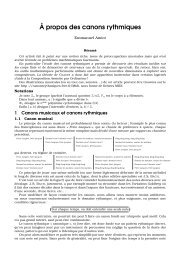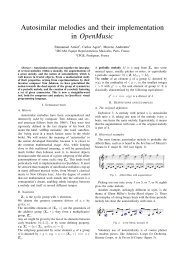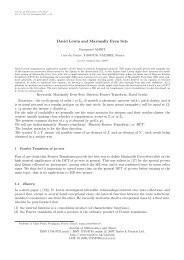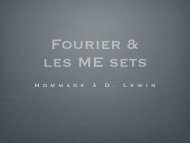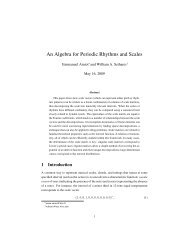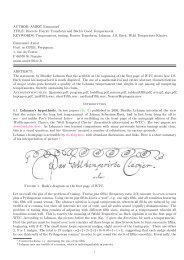Emmanuel Amiot Modèles algébriques et algorithmes pour la ...
Emmanuel Amiot Modèles algébriques et algorithmes pour la ...
Emmanuel Amiot Modèles algébriques et algorithmes pour la ...
Create successful ePaper yourself
Turn your PDF publications into a flip-book with our unique Google optimized e-Paper software.
12 autosimi<strong>la</strong>r melodies<br />
These computations enable to compute a fairly reasonable 1 value of the probability for a melody to be<br />
[primitive] autosimi<strong>la</strong>r, namely the number of partitions of Zn into affine orbits, over the number of all<br />
partitions (e.g. 2 n ). This probability decreases quickly, for n = 20 it is p = 0.000084877 and for n = 72, with<br />
only 480 partitions into affine orbits, the probability is negligible (≈ 10 −19 ). This shows that autosimi<strong>la</strong>r<br />
melodies are highly organised material, and that autosimi<strong>la</strong>rity is a significant feature.<br />
3 Other symm<strong>et</strong>ries<br />
We will remain in the more general context of affine automorphisms x ↦→ a x + b, not only homoth<strong>et</strong>ies.<br />
3.1 Symm<strong>et</strong>ry group<br />
Definition 3.1 The symm<strong>et</strong>ry group of a (periodic) melody M is the subgroup of Affn containing all<br />
maps g satisfying M ◦ g = M, that is to say ∀k M g(k) = Mk. One says that g stabilizes M.<br />
This generalizes Johnson’s remark that a melody invariant under two ratios is also invariant under their<br />
product.<br />
Two extreme examples are a melody that is not autosimi<strong>la</strong>r, meaning its symm<strong>et</strong>ry group contains only<br />
the identity map; and the melody with only one note, which has the whole group Affn for symm<strong>et</strong>ries.<br />
The Alberti bass C G E G C G E G . . . admits all odd ratios for autosimi<strong>la</strong>rity, and more precisely its<br />
symm<strong>et</strong>ry group is made of eight distinct maps mod 8 (this is an abelian group):<br />
x ↦→ x, 3x, 5x, 7x, x + 4, 3x + 4, 5x + 4, 7x + 4<br />
As any autosimi<strong>la</strong>r melody is built up from some map f ∈ Affn, it is obvious that any f k stabilises the<br />
melody. Indeed this means exactly that the melody is autosimi<strong>la</strong>r under map f. The reverse is partially<br />
true:<br />
Theorem 3.2 L<strong>et</strong> M be a primitive autosimi<strong>la</strong>r melody generated by map f : x ↦→ a x. Then any homoth<strong>et</strong>y<br />
g ∈ Affn, e.g. g(x) = c x that stabilises M, is a power of f, e.g. ∃k g = f k , i.e. c = a k .<br />
Maps g(x) = c x where c is not a power of a permute the orbits, that is to say stabilises the rhythmic<br />
structure of the melody, while exchanging its notes.<br />
Proof Assume g(x) = c x stabilises M. In particu<strong>la</strong>r, the orbit O1 which contains powers of a is globally<br />
invariant under g, meaning g(1) = c ∈ O1 is some power of a.<br />
If c is not a power of a, as we have seen already, maps of the kind x ↦→ c x turn Ox into Oc x. <br />
This means, quite significantly, that in considering only the simpler affine maps (homoth<strong>et</strong>ies), only the<br />
obvious symm<strong>et</strong>ries will occur. The picture is of course different in the whole affine group, and we do not<br />
have a general result. Of course, nothing can be said when the melody is not primitive, since col<strong>la</strong>psing<br />
some orbits tog<strong>et</strong>her will increase the symm<strong>et</strong>ry group. Apart from the Alberti Bass, we quote below (fig.<br />
13) one page of the score of Loops for Orchestra by Tom Johnson, wherein the melody admits several<br />
different ratios. The result stands of course for an affine map that is a homoth<strong>et</strong>y, up to a change of origin<br />
– the most frequent occurence as we have seen.<br />
Remark 1 One could also look for the <strong>la</strong>rger subgroup of Affn preserving the s<strong>et</strong> structure of orbits –<br />
meaning that exchanges of notes are allowed. In the case of the theorem above we fall back on the whole<br />
group of homoth<strong>et</strong>ies, isomorphic to Z ∗ n.<br />
In the more general case, the situation can be less simple: for instance the map x ↦→ 3x + 1 (mod 8)<br />
(cf. Fig. 7) yields the melody CCGGCCGGCCGGCCGG. . . which admits 8 symm<strong>et</strong>ries, like the Alberti<br />
1 There are many different ways to define a probability space on melodies, and about as many different probability values. The order<br />
of magnitude of the result stands, however, regardless of the chosen probabilized space.




